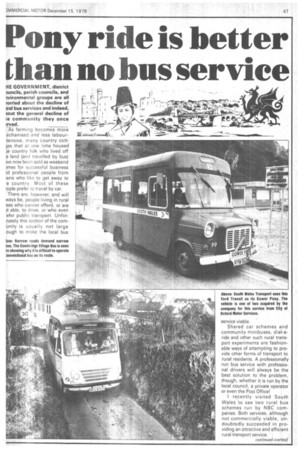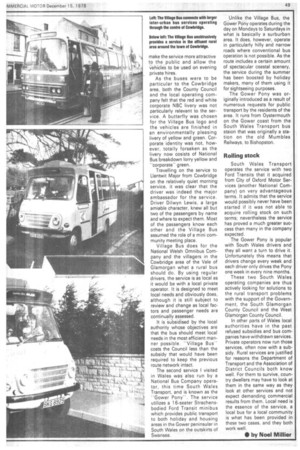Pony ride is better than no bus service
Page 49

Page 50

Page 51

If you've noticed an error in this article please click here to report it so we can fix it.
HE GOVERNMENT, district
D uncils, parish councils, and w ironmental groups are all rorried about the decline of Kai bus services and indeed, out the general decline of le community they once trved.
As farming becomes more echanised and less labourtensive, many country con-, jes that at one time housed Je country folk who lived off e land (and travelled by bus) we noW been sold as weekend )mes for successful business )d professional people from wns who ILke to get away to
e country. Most of these )opie prefer to travel by car. There are, however, and will ways be, people living in rural eas who cannot afford, or are ).t able, to drive, or who even .efer public transport. Unfornately this section of the cornunity is usually not large lough to make the local bus
service viable.
Shared car schemes and community minibuses, dial-aride and other such rural transport experiments are fashionable ways of attempting to provide other forms of transport to rural residents. A professionally run bus service with professional drivers will always be the best solution to the problem, though, whether it is run by the local council, a private operator or even the Post Office! .
I recently visited South Wales to see two rural bus schemes run by NBC companies. Both services, although not commercially viable, undoubtedly succeeded in providing an attractive and efficient rural transport service. The first service I visited is run by National Welsh with the title the "Village Bus". Inaugurated in August 1977 the Village Bus is designed both to replace non-viable conventional bus services and to provide new services for villages not previously served by public transport — a bold attempt to put buses where no bus has gone before.
The Village Bus route network was set up by Western Welsh in the Cowbridge area of South Glamorgan. Cowbridge is a delightful county area that is in many ways to Cardiff what Surrey is to London.
Once the decision to launch the Village Bus was made South Glamorgan County Council sounded out the villages in the Cowbridge hinterland to assess demand and the attitudes of villagers to having a bus service. Surprisingly, some villages preferred to remain busless.
Local needs
The Village Bus routes were designed to link villages with shopping areas and to connect with other, mainly inter-urban type, long-distance bus routes. A feasibility study, external consumer surveys and additional research to the County Council studies helped to pinpoint the most needed routes and those likely to be best supported.
Timetables were originally designed to cater for market days, schools, shopping habits and early closing days for the immediate area and towns on bus routes linked to the Village Bus services.
From the start, the Village Bus was designed to cater for immediate local needs in as friendly a manner as possible. With this in mind, it was decided that the bus would not use regular sign-posted stops but would pick up passengers by request at any safe spot en route. The only actual signposted bus stops on the routes are those where the service covers the same route as an existing conventional bus service.
Initial licensing applications took into consideration the local nature of the service and the Village Bus has been granted authority to operate additional journeys at any time, either on the normal routes or by linking . any authorised points on the group of main bus routes.
The fare system is flexible and inexpensive. Normal fares are reasonable and through fares with other services can be issued. Special non-scheduled services can be run and the company has authority to charge a 50 per cent surcharge if necessary.
Western Welsh or National Welsh, as it has since become, decided that the drivers' attitude would be the make-or-break factor of the scheme. They considered that regular drivers were an essential ingredient for a local service and they selected a team of three drivers from several volunteers. In practice the drivers have stayed with the' service and indeed have contributed to its success.
The team of three drivers work from Cowbridge and only take the vehicles to Bridgend for servicing and repairs when necessary and on scheduled services. The vehicles are fuelled locally and garaged at a South Glamorgan County Council yard in Cowbridge.
Because some of the roads are very narrow, it was decided that special buses would have to be bought to operate Village Bus and as a peak lead of 20 passengers was expected, midi rather than minibuses were chosen.
The Leyland 440EA chassis was chosen, with Asco bodies built to a width of 2.17 metres (7ft 11/2in) which is probably the maximum practical width for the lanes on the routes. The buses were 19-seater Leylands with the Asco Clubman dual-purpose body. The coach type seats help
make the service more attractive to the public and allow the -vehicles to be used on evening private hires.
As the buses were to be particular to the Cowbridge area, both the County Council
and the local operating company felt that the red and white
corporate NBC livery was not
particularly relevant to the service. A butterfly was chosen
for the Village Bus logo and the vehicles are finished in an environmentally pleasing livery of yellow and green. Cor
porate identity was not, however, totally forsaken as the
livery now cosists of National Bus breakdown lorry yellow and "corporate" green.
Travelling on the service to Llantwit Major from Cowbridge on the relatively quiet morning service, it was clear that the driver was indeed the major ambassador for the service.
Driver Dilwyn Lewis, a large amiable character, knew all but two of the passengers by name and where to expect them. Most of the passengers know each other and the Village Bus assumed the role of a mini community meeting place.
Village Bus does for the National Welsh Omnibus Com pany and the villagers in the Cowbridge area of the Vale of Glamorgan what a rural bus should do. By using regular drivers, the service is as local as it would be with a local private operator. It is designed to meet local needs and obviously does, although it is still subject to review and change as local factors and passenger needs are continually assessed. It is subsidised by the local authority whose objectives are that the bus should meet local
needs in the most efficient manner possible. "Village Bus"
costs the Council less than the subsidy that would have been required to keep the previous route network intact.
The second service I visited in Wales was also run by a National Bus Company opera tor, this time South Wales Transport, and is known as the "Gower Pony". The service
utilizes a 16-seater Strachensbodied Ford Transit minibus
which provides public transport to both holiday and housing areas in the Gower peninsular in South Wales on the outskirts of Swansea. Unlike the Village Bus, the Gower Pony operates during the day on Mondays to Saturdays in what is basically a surburban area. It does, however, operate in particularly hilly and narrow roads where conventional bus operation is not possible. As the route includes a certain amount of spectacular coastal scenery, the service during the summer has been boosted by holiday makers, many of them using it for sightseeing purposes.
The Gower Pony was originally introduced as a result of numerous requests for public transport by the residents of the area. It runs from Oystermouth on the Gower coast from the South Wales Transport bus staion that was originally a station on the old Mumbles Railways, to Bishopston.
Rolling stock
South Wales Transport operates the service with two Ford Transits that it acquired from City of Oxford Motor Services (another National Company) on very advantageous terms. It admits that the service would possibly never have been started if it was not able to acquire rolling stock on such terms; nevertheless the service has proved a much greater success than many in the company expected.
The Gower Pony is popular with South Wales drivers and they all want a turn to drive it. Unfortunately this means that drivers change every week and each driver only drives the Pony one week in every nine months.
These two South Wales operating companies are thus actively looking for solutions to the rural transport problems with the support of the Government, the South Glamorgan County Council and the West Glamorgan County Council.
In other parts of Wales local authorities have in the past refused subsidies and bus companies have withdrawn services. Private operators now run those services, often now with a subsidy. Rural services are justified for reasons the Department of Transport and the Association of District Councils both know well. For them to survive, country dwellers may have to look at them in the same way as they look at other services and not expect demanding commercial results from them, Local need is the essence of the service, a local bus for a local community is what has been provided in these two cases, and they both work well.
• by Noel Millier
















































































































